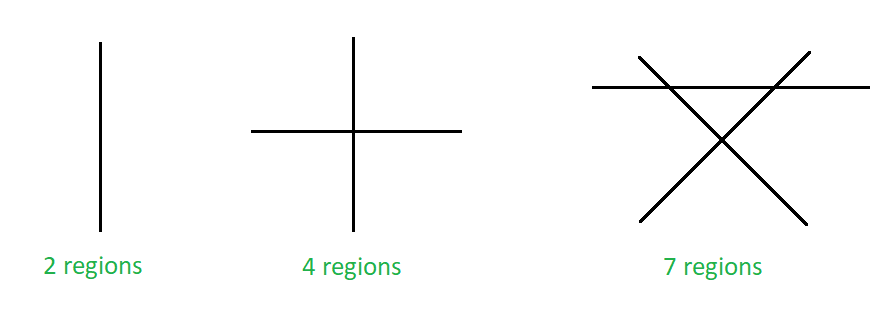Dado N ‘, el número de líneas no paralelas. La tarea es encontrar el número máximo de regiones en las que estas líneas pueden dividir un plano.
Ejemplos:
Entrada: N = 3
Salida: 7
Entrada: N = 2
Salida: 4

Número máximo de regiones en un plano formadas por líneas no paralelas
Enfoque: La imagen de arriba muestra el número máximo de regiones que una línea puede dividir un plano. Una recta puede dividir un plano en dos regiones, dos rectas no paralelas pueden dividir un plano en 4 regiones y tres rectas no paralelas pueden dividirlo en 7 regiones, y así sucesivamente. Cuando la n- ésima línea se agrega a un grupo de (n-1) líneas, el número máximo de regiones adicionales formadas es igual a n.
Ahora resuelve la recursividad de la siguiente manera:
L(2) – L(1) = 2 … (i)
L(3) – L(2) = 3 … (ii)
L(4) – L(3) = 4 … (iii)
. . .
. . .
L(n) – L(n-1) = n ; … (n)
Sumando toda la ecuación anterior obtenemos,
L(n) – L(1) = 2 + 3 + 4 + 5 + 6 + 7 + …… + n ;
L(n) = L(1) + 2 + 3 + 4 + 5 + 6 + 7 + …… + n ;
L(n) = 2 + 2 + 3 + 4 + 5 + 6 + 7 + …… + n ;
L(n) = 1 + 2 + 3 + 4 + 5 + 6 + 7 + …… + n + 1 ;
L(n) = norte ( norte + 1 ) / 2 + 1 ;
El número de regiones en las que N rectas no paralelas pueden dividir un plano es igual a N*( N + 1 )/2 + 1 .
A continuación se muestra la implementación del enfoque anterior:
C++
// C++ program to implement the above problem
#include <bits/stdc++.h>
using namespace std;
// Function to find the maximum
// number of regions on a plane
void maxRegions(int n)
{
int num;
num = n * (n + 1) / 2 + 1;
// print the maximum number of regions
cout << num;
}
// Driver code
int main()
{
int n = 10;
maxRegions(n);
return 0;
}
Java
// Java program to implement the above problem
class GFG
{
// Function to find the maximum
// number of regions on a plane
static void maxRegions(int n)
{
int num;
num = n * (n + 1) / 2 + 1;
// print the maximum number of regions
System.out.println(num);;
}
// Driver code
public static void main(String[] args)
{
int n = 10;
maxRegions(n);
}
}
// This code is contributed by 29AjayKumar
Python3
# Python3 program to implement # the above problem # Function to find the maximum # number of regions on a plane def maxRegions(n): num = n * (n + 1) // 2 + 1 # print the maximum number # of regions print(num) # Driver code n = 10 maxRegions(n) # This code is contributed # by Mohit Kumar
C#
// C# program to implement the above problem
using System;
class GFG
{
// Function to find the maximum
// number of regions on a plane
static void maxRegions(int n)
{
int num;
num = n * (n + 1) / 2 + 1;
// print the maximum number of regions
Console.WriteLine(num);
}
// Driver code
public static void Main(String[] args)
{
int n = 10;
maxRegions(n);
}
}
// This code is contributed by 29AjayKumar
Javascript
<script>
// Javascript program to implement the above problem
// Function to find the maximum
// number of regions on a plane
function maxRegions(n)
{
let num;
num = parseInt( n * (n + 1) / 2) + 1;
// print the maximum number of regions
document.write(num);
}
// Driver code
let n = 10;
maxRegions(n);
</script>
56
Complejidad de tiempo : O(1)
Complejidad espacial : O (1) ya que usa variables constantes
Publicación traducida automáticamente
Artículo escrito por AmanSrivastava1 y traducido por Barcelona Geeks. The original can be accessed here. Licence: CCBY-SA